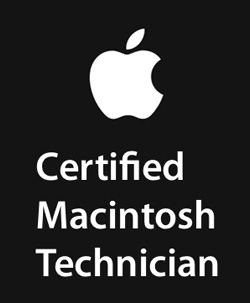Service Fundamentals and Apple Certified Mac Technician (ACMT) Certification
- Course Description
- Course Outline
- Schedule
This course bundle combines the two courses necessary to achieve ACMT certification over 8 consecutive business days.
Part 1: Apple Service Fundamentals teaches students the skills they need to handle face-to-face customer interactions involving all Apple devices. Interactive discussions and hands-on exercises guide students through the best way to manage customer interactions, the required safety precautions, and basic troubleshooting skills.
Students’ knowledge and skills are tested and reinforced by working through real-world scenarios and role-playing.
Part 2: Apple Certified Mac Technician (ACMT) 2016, enables students to become certified to troubleshoot and repair Mac computers. Interactive discussions and hands-on exercises guide students through OS X setup, maintenance, features, and associated services. Students also learn how to troubleshoot OS X and Mac hardware and perform repairs on Mac computers.
Students’ knowledge and skills are tested and reinforced by working through real-world scenarios and hands-on labs. Training for Apple Service Fundamentals and ACMT 2016 is available to technicians who work at or wish to work at Apple-authorized service facilities.
Upon completion of the Service Fundamentals and Apple Certified Mac Technician (ACMT) 2016 course, students will be able to:
- Identify and validate customer engagement skills such as empathy, setting expectations, positioning a refusal of service, and conflict resolution
- Position a repair, upgrade, or attachment so it’s clear that the recommendation helps to solve the customer’s issue
- Identify and validate strategies for setting realistic resolution expectations
- Identify and practice ESD precautions
- Identify the customer statements that generate a Safety First case
- Demonstrate the proper and safe handling of batteries and portable computer case assemblies with a built-in battery, and respond to events that involve these batteries
- Explain why documentation is important to the service workflow. Understand the components of clear, concise, and complete case notes and the negative impact of poor case notes.
- Find and use any Apple product’s serial number to determine its level of coverage
- Describe the importance of accurate troubleshooting to the business and the customer
- Demonstrate basic troubleshooting and deductive reasoning skills, including the use of smart questioning techniques and first-level evaluation and isolation skills
- List the tools and resources that are available to help troubleshoot
- Use Disk Utility to prepare a volume for OS X and describe the OS X installation process using both the Mac App Store and OS X Recovery
- Identify the proper methods to migrate data from one Mac to another using the data migration tools in OS X
- Identify the power states of a Mac running OS X, and describe how to troubleshoot power states on Mac models that don’t have a sleep indicator light
- Explain how to maximize the battery life of an Apple product in a way that a customer can understand
- Identify the different types of accounts in OS X and describe the capabilities of those accounts, including keychain and password options
- Identify and describe various security settings for OS X, including Gatekeeper, FileVault 2, Firewall, Firmware (EFI) password, location service settings, and more
- Describe how to use Time Machine in OS X to create, restore, and manage a secure backup for a customer
- Identify the components of the default OS X environment, including the user home folder and various Library folders
- Describe how to configure and use OS X features, such as Spotlight and Mission Control
- Describe various trackpad gestures
- Use System Preferences in OS X and Apple accessories to configure a wired or Wi-Fi connection to an existing network and securely share data over that network
- Use tools in OS X to configure online services, such as an Apple ID account, iCloud, Mail, and Continuity
- Troubleshoot, evaluate, and isolate a given issue with a Mac to learn how to resolve it
- Given an isolated issue, categorize it as hardware (including accidental damage), software, or environmental, or as an educational opportunity
- Identify the online resources necessary to ensure that a given Mac model is serviced properly and safely
- Describe the purpose of specified diagnostic tools
- Use Apple documentation, approved tools, and appropriate service strategies to safely repair various Mac computers
- Customer Experience Skills and Managing Customer Expectations
- Determining Service Levels
- Documenting Customer Interactions
- ESD Precautions
- Recognizing Safety Issues
- Embedded Battery Safety
- Basic Troubleshooting
- OS X Setup and Maintenance
- OS X File System
- OS X Permissions
- OS X User Accounts
- OS X Security
- Time Machine
- Connectivity
- Mac Troubleshooting
- OS X Troubleshooting Tools
- Troubleshooting Startup Issues
- Service Guides
- Service Diagnostics
- Power Management
- Repairing all Macs
- Servicing Macs

